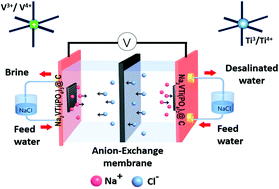An energy efficient bi-functional electrode for continuous cation-selective capacitive deionization†
Abstract
Effective ion intercalation nanomaterials provide tremendous opportunities to various deionization systems such as capacitive deionization (CDI) to significantly improve the removal capacity of brackish water desalination. However, the asymmetric design of CDI devices causes a low removal rate due to the indispensable regeneration half-cycle. Furthermore, choices of chloride selective electrodes for such devices are limited. This imposes a big challenge on further improvement of CDI systems. Herein, we report a cation-selective CDI system using a single bi-functional Na2VTi(PO4)3@carbon nanomaterial with redox couples of V4+/V3+ and Ti3+/Ti4+ as an advanced symmetric electrode. The as-prepared continuous desalination set-up shows a superior removal rate of 0.022 mg g−1 s−1 (1.32 mg g−1 min−1) with a high half-cycle removal capacity of 35 mg g−1, and extremely low energy consumption of 0.14 W h g−1 (at a current density of 100 mA g−1). In addition, an extremely high cycle-stability of at least 50 cycles is achieved. The bi-functional intercalation mechanism is investigated by in situ XRD and ex situ XPS. The symmetric device yields a simplified and low-cost configuration with improved energy efficiency and high removal capacity. This opens a new horizon towards the commercialization of CDI technologies.

- This article is part of the themed collection: 2020 Nanoscale HOT Article Collection


 Please wait while we load your content...
Please wait while we load your content...